Estimated reading time: 4 minutes
The Homemade Ricotta Thermomix method is as easy to make as boiled milk. Once you taste ricotta made using this method you won't go back to commercially produced ricotta. The ricotta just tastes so much better when it's homemade!
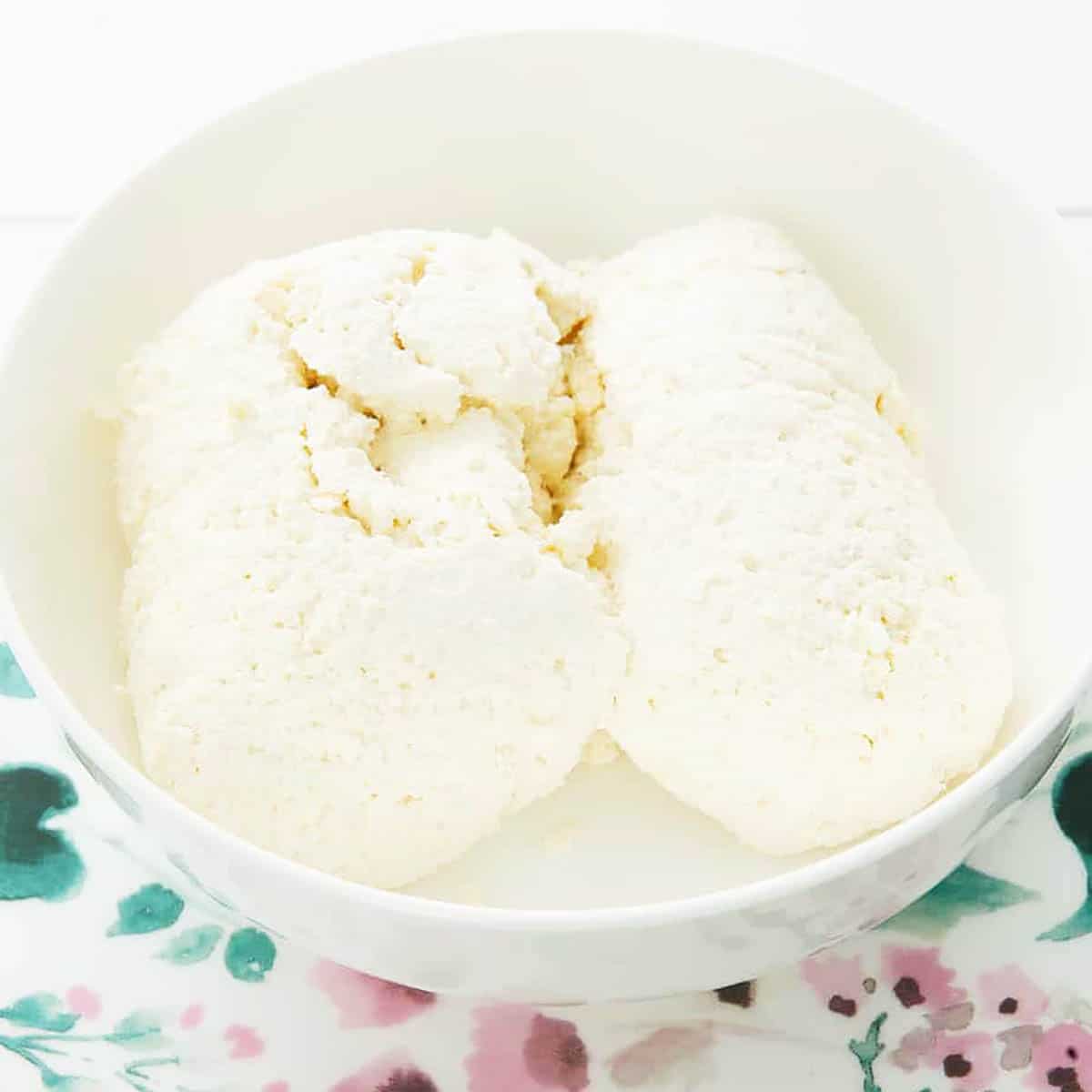
Making homemade ricotta is simple whether you're using a conventional method or the Thermomix. This recipe includes only two ingredients; milk and a curdling agent, either lemon juice or vinegar.
The trick to getting the best yield from the process is in the method used. So whilst every method will be the same, knowing, what you are doing and why can be the difference between getting 100g of ricotta or 500g of ricotta from the same amount of milk?
How to Make Homemade Ricotta
There are two ingredients used in making ricotta cheese.
- Milk
- Acidic liquid to curdle the milk - you can choose to use either lemon juice or vinegar. I choose vinegar because it is easier to pour vinegar from a bottle than to squeeze lemons and vinegar is also cheaper. Use white vinegar so you don't stain the ricotta.
There are three processes involved in ricotta making.
- Heating the milk to boiling point.
- Adding the vinegar and giving a single stir to combine (2 seconds).
- Allowing the curds to knit without being disturbed.
This method produces the most curds as the curds are not stirred back through the whey. They are allowed to knit into a solid mass which forms on top of the whey. This recipe should yield about 500gm of fresh ricotta cheese.

Homemade Ricotta Steps
- Heat the milk to 98-99 degrees, (195 Fahrenheit).
- Add the vinegar to the milk.
- Stir the milk & vinegar mixture just once around the saucepan, (2 seconds).
- Allow the curds to sit undisturbed for 30 minutes.
- Curds will form a raft on top of the whey.
- After 30 minutes drain the mixture through a cheesecloth.
- Hang the cheesecloth to further drain for 10 minutes depending on the level of moisture you would like in your homemade ricotta.
More Tips
- Don't use flavoured or colour vinegar such as red wine vinegar or balsamic vinegar. These will colour and flavour the ricotta. Use only white vinegar or lemon juice.
- Use UHT milk if it's available, it's cheaper and produces a good yield.
- Times in the Thermomix are given for milk starting at room temperature.
- Full cream milk must be used to make ricotta. Skim milk will yield a very small quantity of ricotta.
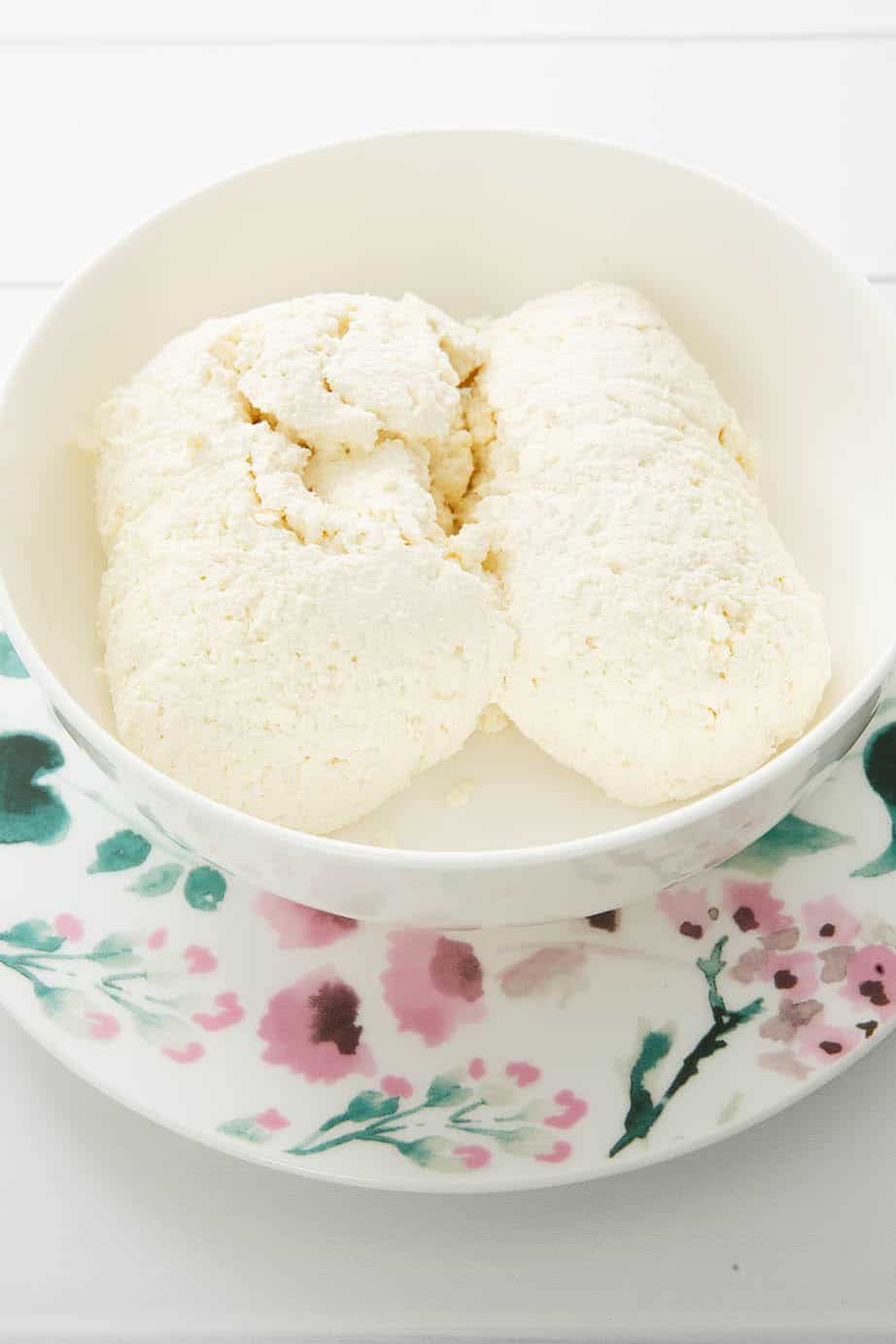
FAQ Homemade Ricotta
The ricotta will keep in a sealed container for 5 days. After that, it may be time to make another batch.
If you freeze your ricotta the texture will change. This may make it unpalatable for some uses. I would be very cautious about freezing ricotta.
If you use skim milk you will get a much small yield. It is not very successful.
YES! I don't know why people say you can't use UHT milk. The proteins may be affected by the heating process but UHT milk provides the best yield, the curds knot together better.
There are two reasons why your milk may not have curdled properly.
1. The milk didn't reach boiling temperature, in this case, continue to heat the milk.
2. Not enough vinegar was added to the milk or it wasn't stirred through. Repeat this process.
If you have a cloudy whey (this usually indicates the curds have not separated properly. See the above question regarding the milk not curdling properly. If you can see small particles in otherwise clear whey then you have over-stirred the whey and not allowed the ricotta to knit effectively.
Let’s Connect!
I share loads of great recipes on the page. Our community group page is a fabulous place to ask questions and share images of recipes you have made! It helps inspire others to cook new and interesting dishes.
If you want more Thermomix recipe ideas, please follow the ThermoKitchen FB Page.
For more Thermomix recipe inspiration LETS CONNECT on;
FACEBOOK
TWITTER INSTAGRAM PINTEREST YOUTUBE
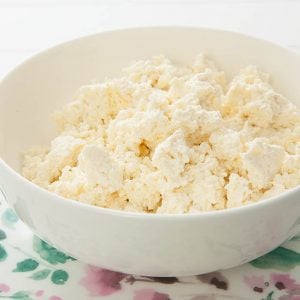
Homemade Ricotta Cheese
Ingredients
- 2000 g full cream milk
- 80 g white vinegar or lemon juice
Instructions
- Place the milk in TM bowl. Heat 15 min/98 degrees/Speed 2.
- Add the vinegar to TM bowl. With a spoon manually stir one complete circle to combine the milk and vinegar.
- Leave the contents in TM bowl undisturbed 30 minutes.
- Line the internal steaming basket with cheesecloth or clean Chux dishcloth.
- Using a slotted scoop the ricotta into the internal steaming basket.
- Allow the ricotta to drain for 5 -10 minutes.
- The ricotta can be used immediately or stored in the fridge for up to a week.
Homemade Ricotta - Conventional Method
- With the aid of a cooking thermometer heat milk in a heavy-based saucepan until it reaches 99 degrees Celsius (195 Fahrenheit)
- Continue as per the Thermomix method.
Notes
Nutrition
I hope you have enjoyed this story. Feel free to leave a comment or start a discussion. If you have made a dish from this site I would love to know what you thought!
Leaving a comment and a star rating helps others decide if they should try my recipe. Plus if you hit the social media share buttons, your friends may find a delicious new recipe or Thermomix Tip too!
If you want to be notified when a new recipe is released sign up for my monthly newsletter. The form is also in the footer!
Thank you for stopping by,
Happy Cooking
j xx

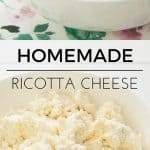

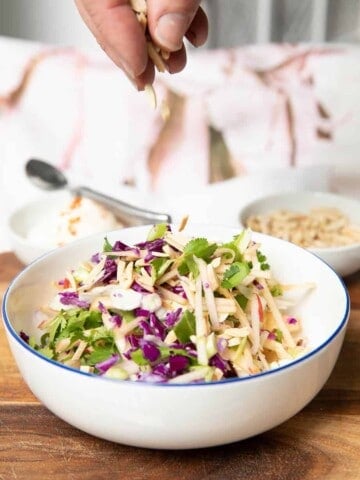
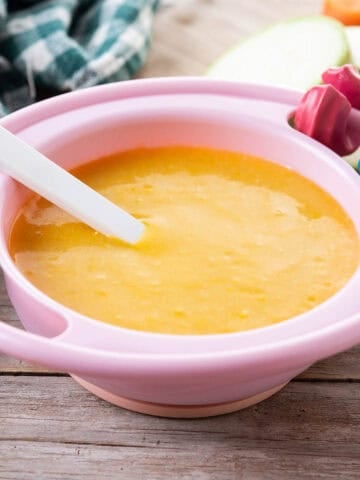
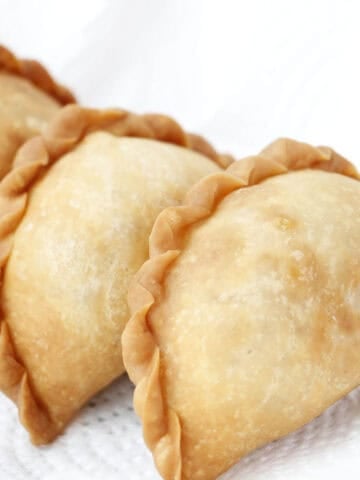
Donna says
Love this recipe -fresh ricotta is amazing
Julie Carlyle says
Hi Donna
I absolutely agree, fresh homemade ricotta is a gamechanger. It tastes so much different to deli ricotta or the comercially produced product.
Thank you for leaving a comment.
Happy Cooking
Julie
Heather says
First timer with ricotta and it was the best. I used fresh lemon juice and grated the time as I wanted the sweetness for a recipe. Wing on all levels because we are the ricotta on its own and there was none left for cooking. Thanks again
Barbara Nelson says
I just made this ricotta in my ancient TM21 and it turned out amazing. Thanks for recipe
Julie Carlyle says
Hi Barbara
WOW! I didn't know the TM21 even came out in Australia!! That is fabulous! So pleased you enjoyed the recipe!!
Thank you for coming back and letting me know 🙂
Happy Cooking
j
Rolmat says
Hi, I use to make my Ricotta with the Microwave and thought this morning, why not my Thermomix since I already make my yogourt so easily with it? Nothing to clean except the bowl!
I will try your way because your recipe is similar to mine (only I put 1/2 ts salt)
After reading the comments, let me share something: when I first started to make Ricotta, I was astonished by the amount of leftover liquid to throw away. I now use it for any Creamy soup instead of milk. No one ever complained of a taste of vinegar. I even freeze it if I am not planning to make any soup in the following days. So, here was my 2 cents!
Julie Carlyle says
Hi Rolmat
Thanks so much for your message! What a fabulous idea for the leftover whey! I will have to try that!
Happy cooking
Julie
Belinda Leventis says
Hi Julie, I made this last night for the first time and it was great! Only thing, can you add anything so there isn't a distinct taste of vinegar when you eat it on its own?
Julie Carlyle says
Hi Belinda
If you can taste the vinegar you may need to drain and press the curds. You can also wash the curds then drain if you can still taste the vinegar.
Christina hamilton says
When leaving the milk and vinegar in the bowl for 30mins is that with the lid on with the Mc or no lid
Julie Carlyle says
Hi Christina,
Thank you for your question. Once the vinegar has been added to the TM bowl and you are “resting the curds” it won’t matter whether the lid is on or off. This is just a chance for all the curd to knot together and separate from the whey.
Happy cooking.
Julie
Melissa Sinclair says
Hello! I've made this so many times and have never added the vinegar at step 1....today I started to 🤦♀️🤦♀️...luckily it was only a splash I think...do you think it will still be okay?!
Julie Carlyle says
Oh Dear,
I don't think you will have much luck with this, the best you can probably hope for is a low yield of ricotta 🙁
Sorry to be the bearer of bad news
Julie
Mary Lyle says
You are right about heating to 100. Huge mistake today. Put in the 2 litres went off to computer land. Came back to nearly 1/2 milk over the bench and floor. Bonus for Mallie the kelpie but very low yield for me.
Sue says
Hi, can you use low fat milk for recipe. Thanks
Julie Carlyle says
Sorry Sue, you absolutely need to use full fat milk otherwise the ricotta yield is really poor. 🙁
The ricotta is very low in fat anyway 🙂
Happy cooking
J
Catherine says
I’ve got the older tm31 and can only set it to heat to 90 or 100 degrees. Would 100 be too hot? Thank you
Julie Carlyle says
Hi Catherine
Set the heat to 90. Once the milk has reached this temperature increase it to 100 and watch VERY carefully, the milk needs to reach 100 for just a second before it’s turned off and the vinegar is added. Milk will book over at 100 degrees, so please watch it carefully.
I hope this helps.
Happy cooking
J
Claudia says
Hi, can you add salt to the Thermomix recipe? If so, when is the time to add it?
Julie Carlyle says
Hi Claudia
If you would like to add salt its added while the milk is heating, this will make the milk and salt combine before the curds are separated. Ricotta with salt added is perfect for savoury recipes but I wouldn't add the salt if some of the ricotta may be used for sweet recipes such as cheesecake.
Happy cooking
Julie
Manda says
Is there anything you can do with the leftover liquid?
Julie Carlyle says
Hi Manga,
The leftover liquid is good to use on the gard as fertiliser as its high in protein. I'm not sure what else it can be used for though???
j
Betty Thompson says
Used low fat milk accidentally, before I read to use full fat.
I halved the recipe and it made 170g of ricotta.
I boiled the milk for 15 mins on 100 (TM3) speed 2. Hope that was correct?
Thanks for the recipe, it was easy and fun to make.
Julie Carlyle says
Hi Betty
The only real problem with using low-fat milk is the ricotta yield you get is far less. It is still delicious homemade ricotta. 🙂
Happy Cooking
j
Catherine says
Do you use white vinegar (cleaning) or white wine vinegar (salad) ?
Julie Carlyle says
Hi Catherine,
Any white vinegar will work fine in this recipe.
Happy Cooking
j
Kylie says
Do you know how the times may differ if I was to halve the recipe?
Julie Carlyle says
No I'm sorry I don't know Kylie.
Feel free to try it and let me know. I will share it with readers.
Julie
Jane says
Whoops, I have just read that the 500 gm of ricotta serves 6
Jane says
Great recipe and thankyou for the nutritional values, however I was wondering how big is the serving size?
Aimee M Mackie says
Approximately how much ricotta does this recipe make Julie?
Julie Carlyle says
The yield of ricotta will always vary depending on the solids available in the milk and how well the solids knit after thre curdling process. Between 500- 700g is probably a good estimation. So it’s pretty economical for a $2 investment 🙂
Emma says
Great simple recipe! Any tips on how to make it less stiff/more moist? Mine turned out a little dry and possibly too crumbly.
Julie Carlyle says
Hi Emma,
Thanks for the question. You can make ricotta more moist by not draining it for as long. There will be more why left in the curds and the ricotta will be more moist. X
CJ says
Nooo baby brain me has just added the vinegar before I heated the milk. Can it be saved? 😩
Julie Carlyle says
Oh no 🙁 What a shame... Unfortunately, the vinegar has to be added when the milk is at temperature. So sorry 🙁
Alexandra Young says
Hi there, can you use Goats milk?
Julie Carlyle says
Hi Alexandra, yes goats milk is suitable to make ricotta although the volume yield will be less as the goats milk isn't as high in fat.
Lucy says
it is easy to make and taste great. Thanks for sharing.
Julie Carlyle says
I'm so pleased you liked the recipe Lucy, I will have to include more dishes that use ricotta as an ingredient on the website 🙂